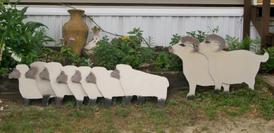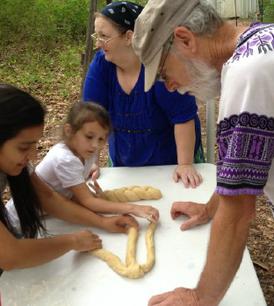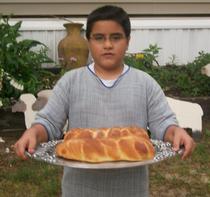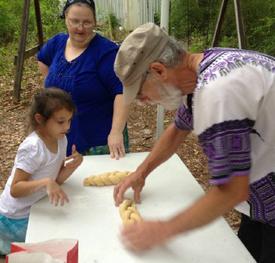The Feast of Weeks
Shavuoth ("shah-voo-OAT"), which means "weeks", is the next of the three pilgrimages to Jerusalem in which all grown and able-bodied men are to appear before YHWH. (Ex. 23:16-19) It is the culmination of a "week of weeks"--that is, seven weeks, in which we are specifically commanded to count the days. These seven weeks lead up to this feast, but do not include it. It is on the fiftieth day.
The seven weeks are called "the Counting of the Omer". This begins shortly after Passover, and still within the Feast of Unleavened Bread. On the first day, which is called Yom haBikkurim (the day of the firstfruits), the first and best of the barley harvest is brought to the Temple for the priests.
In ancient times there were three ways of understanding when the firstfruits were to be brought. The actual Scriptural command is:
"On the morrow after the Sabbath..." we are to bring two loaves made from two tenths of an eyfah of fine flour, along with seven flawless year-old lambs, one young bull, two rams for an ascending offering, one male goat for a sin offering, and two male lambs to be a peace offering. (Lev. 23:15-22; see also Deut. 16:9-10; 26:5-8)
The Sadducees took this Sabbath as the ordinary weekly Sabbath that falls during the Feast of Unleavened Bread (except that day 1 must always be within the seven days of Unleavened Bread, so if Passover was at the end of a Sabbath, they would begin counting the first day of the feast, as the next Sabbath would be the last day ofd the feast, and thus they would not begin counting the Omer AFTER the feast was already over). The Pharisees took it to mean the first day of the Feast, thus the counting of the Omer for them always begins on the 16th of Aviv.
The Essenes began counting on the day after the Sabbath (Sunday), but after all of the seven days of Unleavened Bread were over.
Rabbinic Judaism today follows the Pharisaical view, while we, along with the Karaites and others, follow the Sadducean view, so that Yom haBikkurim always ends up being on the first day of the week, as does Shavuot. This is because there is another Hebrew word used for Festivals, Shabbaton (which means "a great Sabbath" or "high day"), while the only commanded festival ever simply called a Sabbath in the Torah is Yom Kippur, which is a "ceasing" but not a feast. (Lev. 16:31; 23:32) We are also commanded to count "seven complete Sabbaths" (Lev. 23:15), but in the Pharisaical count, one can count seven weeks, but there might not always be both seven Sabbaths and seven weeks. (For example, if the first day of Unleavened Bread fell on a Friday, the firstfruits would be brought on the Sabbath, but then this would count as the first Sabbath, and the seventh Sabbath would only be six weeks after the count began, and the count would only reach 43 days instead of 49.)
But what is it that we are counting up to? There’s a clue given as Israel is gathering at Mount Sinai. YHWH told Moshe, "Go to the people and set them apart [as dedicated] today and tomorrow, and let them wash their clothes and be firmly prepared for the third day, because on the third day YHWH will come down…” (Ex. 19:12)
They haven’t yet been told to count in this season, but you can feel the anticipation in the air as they camp before this mountain, called “the mountain of Elohim”. (Exodus 3:1) Moshe must have had a different—more confident and settled—demeanor about him, because this was the sign YHWH had given him when He first met him at the burning bush: “I will be with you, and this will be the proof to you that I have sent you: When you bring the people out of Egypt, you will serve Elohim on this mountain." (3:12)
Now, after the Reed Sea, they have arrived. It was all true; YHWH really was with him, in spite of his initial fears. After all the evidences of His faithfulness have come true, as Moshe starts climbing that very mountain, YHWH gives him something to tell all the people he has brought there:
“You have seen what I did to Egypt and how I carried you on the wings of eagles, and gathered you to Myself. So now, as you hear, if you will [really] listen within My voice, and guard My covenant, you will become to Me a uniquely-valued [and guarded] treasure above all of the [other] peoples--because though all of the earth is Mine, you shall become for Me a kingdom of priests, a nation of a completely different kind.” (Exodus 19:4-6)
Do you realize how astounding that is? They just saw Him bring the most advanced civilization in the world to heel—and to ruin. What the Pharaohs had spent countless generations tying to make for themselves, and more, YHWH was offering to this horde of freed slaves! You don’t get that kind of big break every day! Yeshua caught the drift of how extraordinary this was. That kingdom that YHWH offered to make us was something so special, so far beyond the value of anything else anyone had ever heard of, that it was worth risking everything else for and “going for broke” (Matithyahu 13:44), because it was that kind of treasure.
And the people did catch on. They saw what YHWH had already done, and even before they heard what He was going to tell them to do, they said, “We’ll do it, whatever it is!” (Ex. 19:8) But was that only because of their fear of the earthquakes, fire, and billowing smoke? Because only a few weeks later they were bowing down to a big hunk of metal.
But fast-forward some 1,500 years, apparently on the same day of the year, and here we see some people who do go for broke. After they experience not just redemption but rebirth, those multitudes from all around the world who had come to Yerushalayim for the feast (as they had been commanded to) were rewarded for going to such lengths to obey, even though they lived in far-flung places. (Acts of the Envoys chapter 2)
What they got to hear and see that day was so riveting that soon they were selling off their properties out there among the nations and forming what under any other circumstances would be called a commune. It was a community in which they shared all their material possessions, because they had seen them to be merely incidental. What they were getting to hear day by day about the Kingdom that Yeshua had ignited was indeed worth selling everything else to be a part of. (2:41-47)
Of course, it wasn’t all fun and games. The powers of darkness that had been entrenched, some since the Babylonian captivity, some since the Tower of Bavel, and some since the Garden of Eden—the “deep state” of that day—were not about to give up their strongholds so easily. They lashed back and many of these people on whose heads the flame of Sinai had appeared lost their freedoms, their homes, or their lives in the process. But it didn’t sway them. They hung in there. They knew they had “a more lasting home”—a “city with real foundations, built by none other than YHWH Himself”. (Hebrews 11:10) And that is what they invested everything in, not compromising so that they could arrive there—battered, bruised, and torn, maybe, but unsullied.
At Sinai, YHWH gave us a head start that He gave to no other nation, not so we could win a race, but so we could blaze a trail for others to follow. At the other “mountain of Elohim” (Moryiah—for it was in the House that the second Shavuoth outpouring took place), He opened the door much wider for not just those who were near, but those who were far off (Acts 2:39, based on Daniel 9:7) could enter the path.
Oh, it was still a narrow road, barely visible at times, and a tight squeeze that a fully-loaded camel could never navigate. We have to jettison everything else to make it through. But it is available, even to those who had once left the covenant, because it has been renegotiated with a much more costly ransom—not just the firstborn of Egypt but the firstborn of all creation, YHWH’s own masterpiece He sacrificed so that we could approach Him again and draw truly near to one another in a way that had never been experienced before.
So are we preparing for “the third day”? Remember it had to do with washing our garments. Yeshua highly commended those who had never even gotten them dirty; “they will walk with me in white, because they are deserving [of this].” (Rev. 3:4) Not all of us are that way, but “clean, white garments” are a picture of righteousness. (Rev. 19:8) How do we get them clean again? Those who show up later with white robes “have washed their robes and whitened them in the blood of the Lamb.” (Rev. 7:14) The way has been provided for anyone to have a wedding garment.
But once we get there, we need to keep them clean. And we can’t show up without what has been provided to even those who could not otherwise afford it. He warned, “I am coming like a thief! Blessed is the one who stays awake [and alert] and keeps his garments.” (Rev. 16:15) How do we do that, metaphorically? Later he explained, speaking of YHWH his Elohim, “Blessed are they that do his commandments, that they may have right to the tree of life, and may enter in through the gates into the city.” (Rev. 22:14)
Keep His commandments so we can…hear His commandments? For that’s what they did at Sinai. Yes! Moshe said, “If I have found favor in Your sight, show me Your way so I may know you—so that I can find favor in Your sight!” (Exodus 33:13) It’s an ongoing cycle--not a circle that goes nowhere, but one that spirals higher and higher. YHWH came down on the third day, but also “on the third day He will raise us up, and we shall live in His sight”. (Hoshea 6:2) That has many ramifications, which you can dig out. But Proverbs 4:18 tells us, “The path of the righteous is like the light of the dawn, which grows brighter and brighter until the fully-prepared day.”
That sounds a lot like Shavuoth. “When the day of Shavuoth had fully arrived” (the count was complete) and they were all in unity (Acts 2:1), then the fire fell, and the rest is history. Are you “fully prepared” for what YHWH might do this time?
* * * * *
Shavuoth is the firstfruits of the wheat harvest. The two loaves of wheat bread are to be baked with leaven this time. (Lev. 23:17) This means that during this season leaven is a picture of something different from during the Feast of Unleavened Bread, where it symbolizes sin and pride. Yeshua gives us a clue in his parable of the woman who hid three measures of leaven in her dough until it was fully leavened:
"The kingdom of the heavens is like leaven..." (Mat. 13:33)
So leaven is a picture not of sin, but of the Kingdom, during this season. In every case, leaven is something that thoroughly permeates. Sometimes the result is negative (as depicted at Hag HaMatzah) and sometimes it is positive (as here).
The Mishnah (a Jewish commentary on the way Torah commands were carried out during Second Temple Times) tells us that landowners would mark the first produce to ripen. When it was time to bring them up to the Temple, the men would gather in open squares of the towns designated for each priestly course, sleep outside to be sure they would not contract corpse-uncleanness, and depart at dawn walking behind an ox whose horns were overlaid with gold with a wreath around its head, and a flutist would walk before them to Jerusalem. The rich brought firstfruits in baskets of silver and gold, while the poor brought them in baskets made of peeled willow branches. They would decorate the firstfruits with other forms of produce, and on arrival in Jerusalem, recite the declaration in Deut. 26:3-10, but only for the firstfruits of the seven species for which Israel was known: barley, wheat, grapes, figs, pomegranates, olives, and dates.
There are strong parallels between the five ministry gifts listed in Ephesians 4:11-16 and the process of bringing the wheat (us) to maturity so it can become bread (which represents unified community, according to 1 Corinthians 10:17):
The evangelist harvests (removes from the ground where we grew up)
The pastor/shepherd threshes (gently separates from what once protected us and acclimates to the new environment)
The teacher winnows (elevates us to where the wind/spirit can do its work)
The prophet roasts (brings fire in a controlled way to remove the unusable weightiness of self)
(YHWH Himself does the crushing between the two stones of the Torah)
The apostle sifts (tests to see where each fits and if each is ready to blend in with community or is still too much of an individualist to fit through the sieve).
The flour used for the two loaves for the Temple at Shavuoth was passed through thirteen different sieves, each with a finer mesh. (Thanks to Rabbi Micha'el Washer for these insights.)
Bikkurim ("firstfruits") also means "firstborn", so we can see many analogies with how we ourselves should present to YHWH the first and best of all our resources, our generous thoughts, and in a figurative sense, our children.
Yom haBikkurim is the day Yeshua was resurrected--or known to be. While usually translated "on the first day of the week", in Greek it actually says, "[day] one of the Weeks", i.e. the seven weeks. (Mat. 28:1) This is confirmed when Paul calls Yahshua "the firstfruits of those who have fallen asleep". (1 Cor. 15:20-23)
It was probably on the 17th of the month that year, three days after Passover, and on the anniversary of Noah's ark coming to rest (Gen. 8:4), and by tradition the anniversary of Israel coming out of the Reed Sea, and Haman being hanged--all pictures of redemption.
Some other names for Shavuoth are Hag haQatzir ("feast of the harvest"), "the fiftieth day" (Pentecost in Greek), and the Firstfruits of the Wheat Harvest.
Themes of the Counting of the Omer and Shavuoth:
Growing to fullness of Maturity
Giving of the Torah at Mt. Sinai (which tradition says took place on Shavuoth)
The offering of the Torah to all 70 nations (though only Israel accepted it)
The wedding of YHWH and Israel (under the chuppah/canopy of the uplifted mountain – Ex. 19:17). In this scenario, Passover is seen as His courting Israel, and Sukkoth as the setting up of a household faithful to the Torah.
Jewish Traditions in regard to Shavuot include staying up all night to study the Torah (because tradition says the Israelites overslept at Mt. Sinai on the day the Torah was given), and to study some part(s) of it that one does not normally study to "give the Torah a beautiful birthday present". Another is to read psalms (because David was born and died on this date), and to read the story of Ruth (which takes place in the barley harvest). Synagogues are decorated with greenery to celebrate the harvest theme, and homes are decorated with branches and especially with roses.
The account of the Shavuoth (better known by the Greek term "Pentecost", which simply means "fiftieth") the year of Yeshua's resurrection and ascension (Acts chapter 2) seems to confirm the tradition of David dying on that day, since Keyfa ("Peter") alludes to David being long dead and his tomb being still with us. (2:25-29) One of the traditions on the day of someone's death is to visit their tomb, so Kefa would have been speaking to people who either had just done so or were preparing to do so soon thereafter.
The themes of the fullness of maturity and being completely unified are clear in this account:
"When the day of [Shavuot] had fully arrived, they were all in one place and in perfect harmony [or unison, with one mind, in full agreement], and suddenly there came from the skies the sound of a mighty, rushing wind…and there appeared to them tongues of fire that were distributed and settled down on each of their heads." (Acts 2:1-3)
This clearly recalled the thunderings and fire descending onto Mount Sinai the day the Torah was given (Exodus 19:18; 20:18), and it is easy to see how YHWH marked this year of the renewal of the covenant with the refreshing of the offer of the Torah to all nations, as the message of the apostles was spoken to each of the pilgrims to Jerusalem in their native tongue. And a tikkun ("tee-KOON", meaning reparation or reversal) was made for the incident of the golden calf, for which 3,000 people was struck dead in one day, because on this day the book of Acts tells us that 3,000 souls were added to the ranks of those who followed the Messiah. (2:41)
Counting of the Omer
One of our family traditions, since we got married on the 49th day of the omer (the count from after the sabbath following Passover until Shavuoth described in Lev. 23:15) has been to follow Simon Jacobson’s A Spiritual Guide to the Counting of the Omer. It is based on a Jewish mystical conceptualization called the Sefirotic Tree, which is a representation of the “godhead” from which the doctrine of the trinity may have been adapted since it includes three columns called the “father, mother, and son”. This representation is called the body if the Adam Qadmon (“Most Ancient Man”, prototype for Adam and arguably the Word/Memra/Logos fleshed out again in Messiah, “who is the image of the invisible Elohim” per Col. 1:15—one reason we are not to make images of YHWH; He has already made this sole authorized image which we are not to worship but to honor and follow as master). It does bear many similarities to the way Yeshua is actually described in the Renewed Covenant, prior to the Council of Nicea’s solidifying a doctrinal form which does not always fit with the text.
This Sefirotic Tree is called this because it consists of ten sefirot, or attributes of the transcendent Creator, three of which are said to be characteristics only possessed by YHWH Himself, while the lower seven are traits we too can and must emulate as creatures that still bear a vestige of His image (Gen. 5:3) and can gain more of it back through being born again of Messiah’s spiritual “seed” or DNA. This schema fits the seven weeks (7 x 7) by focusing on one of the seven (lovingkindness, discipline, harmony/compassion, endurance, splendor/humility, bonding, and leadership/sovereignty) each week and then within that week, combining the seven again with that week’s theme to bring out a different aspect of that targeted area of growth. The idea is to build ourselves up in each of those areas so that we are more mature and ready for the day on which, by tradition, the Torah was given.
Paul, a master rabbinical scholar, seems to have had this very concept in mind when he wrote to the Ephesians—whom he calls “former Gentiles”. (Eph. 2:11) Chapters 4 and 5 especially bring out these same concepts of emulating YHWH’s traits and growing to complete maturity in them. While Jacobson focuses on personal growth in these areas, Paul says there is a communal aspect to them as well. I’ll just cite a few highlights and you can take them from there…
“Walk in a manner befitting [the worth of] the calling whose [name] you are invited [to bear], with all humility and gentleness, with patient endurance, putting up with one another in committed love, being diligent to carefully guard the unanimity of spirit in the bond of [harmonious] peace.” (4:1-3)
“To each of us is furnished a supply of capability according to the extent determined by what the Messiah provides…some [as] delegated envoys, some spokesmen, some bearers of glad news, some shepherds, and some teachers toward the complete equipping of those who are set apart for the task of the ministry—for the building up of Messiah’s body until we all arrive at the unanimity of conviction and of the [precise] correct understanding of the Son of Elohim, aiming to be a complete man, attaining the [proper] measure of maturity of what brings [the] Messiah to [his] fullness.” (4:7, 11-13)
Messianic author Micha’el Washer (in When All the Pictures are Restored) pointed out that these “five ministry gifts” correlate with the process (reaping, threshing, winnowing, parching, sifting) of turning grain into bread—individuals kernels into one whole new entity—for that is what is brought at Shavuoth, as the firstfruits of the wheat harvest.
“...that…we may all grow up into him who is the head—the Messiah—from whom the whole body, being laid out and framed together and caused to coalesce by means of every joint that assists according to the energizing through one standard measurement of each of the constituent parts, producing [for itself] the growth of the body into [something that can keep] building itself up through benevolent affection.” (4:15-16)
Since with Messiah as our Head Jews and Gentiles are reformulated into “one new man” (2:15), we are to “put off the old man, which is being [further and further] corrupted in accordance with the deceitful cravings for what is forbidden, be renewed in the disposition of your mind, and put on the new man—the one [that is] in agreement with Elohim… So, putting off what is false, each must speak the truth with his neighbors, since we are members of one another.” (4:22-25)
“Be imitators of Elohim, being dearly-loved children.” (5:1)
May you and those you sharpen like iron know this kind of growth this year as you count up to maturity!
When, Where, and Why? (Exodus 19; Deut. 4)
Which day is it?
Rabbinic Jews celebrate Shavuoth the 6th day of the 3rd month, counting the 50th day from the 16th of Aviv, the day after the first high day of Unleavened Bread. But then there must always be 29 days the 1st month and 30 the 2nd, or vice versa, regardless of the actual new moons--not unlikely, but dangerous to assume.
Torah (Leviticus 23:15) says Shavuoth falls the morrow after “7 complete sabbaths” (shabbathoth). It does not say “7 weeks” (shavuoth) as if the final day of the Counting of the Omer could be any day of the week; it begins the day after a sabbath, and ends on a sabbath. The only way this works is if they start the day after the weekly sabbath, not an annual one. We have to use the terminology consistently; if you take the first “sabbath” to be a high day of the festival (a shabbathon), the final day also has to be a shabbathon, but there is none then; the day after it is the high day. This, not what led up to it, is called Shavuoth in the actual text, which matters most.
A variation on this is the Tzadoqite priestly tradition a practiced at Qumran (where the Dead Sea Scrolls were hidden): They began the count the day after the sabbath AFTER the last day of the Feast, whereas the Tzadduqim (Sadducees) began the day after the weekly Sabbath that falls during the Feast. But still it begins on the first of the week and ends on Shabbat.
Thus these (Firstfruits of the Barley Harvest and “Shavuoth, the Firstfruits of the Wheat Harvest”, Ex. 34:22) are the only two “Sundays” that are always holy. It is therefore so very fitting that Messiah is called “the firstfruits of those who had slept”. (1 Cor. 15:20-23) His resurrection was discovered literally on “the first day of the weeks” (plural, not just “week”). (Mat. 28:1) It also says this took place “after the sabbaths” (again plural—for he was in the grave the first high day of Unleavened Bread AND the weekly sabbath; that’s also the only way he could have been there three days and three nights).
Was the Torah given right on Shavuoth?
Tradition says yes, and logic would say that for this day to have been one of the 3 biggest festivals of the year (Ex. 23:17; Deut. 16:16), something major probably occurred that day. Can we prove it from Scripture? Almost, but not quite. It has to be early in the 3rd month, for on that new moon Israel arrived at Sinai. (Ex. 19:1-2) Then 3 more days are mentioned. (Ex. 19:11-12, 15) So it appears that YHWH was seen on the mountain on the 3rd (or possibly the 4th, 3 days after the 1st) of the month, not the 6th as in the rabbinic count. That year Passover (the 14th of the first month) would have had to be only one day or at most two before the weekly Shabbat for Shavuoth to fall on the 3rd or 4th of the 3rd month.
Does it matter? YHWH didn’t see fit to say it was the same day that He would later command us to observe. But the giving of the Holy Spirit came on a Shavuoth over 1,500 years later at what is called “Pentecost” from the Greek for “50”(th day). That it would be the same day is the way YHWH often does things, so it is very likely the day the Ten Commandments were spoken aloud in the hearing of the whole nation--but not absolutely certain.
Where did this take place?
Mt. Sinai was smoking because YHWH descended on it with fire (Ex. 19:18); Jabal al-Lawz in Saudi Arabia (compare Galatians 4:25), very close to Midyan (Ex. 3:1), has a blackened summit but is not volcanic. Numerous artifacts that fit the text have been found there in the last few decades, in contrast with the traditional site in what in reverse psychology was named the Sinai Peninsula by the likes of Constantine’s mother, where no evidence of a huge camp has ever been found.
“You came near and stood under the mountain”. (Deut. 4:11) That is literally what it says—not “at the foot of” as some, convinced that this was impossible, render it try to explain away the anomaly. The rabbinic interpretation is that the mountain formed a wedding chuppah where YHWH married Israel. The scientific explanation is a close flyby of a planet (or similar) with a strong enough gravitation to lift the mountain off the ground so the nation could literally walk beneath it. (Refer to Donald Patten’s writings for a fuller explanation of such occurrences.)
And Why?
“YHWH spoke to you from the midst of the fire; … but you saw no form.” (Deut. 4:12) Flames have no shape; like Him, they move where they need to—often consuming, but not always. (4:32-33) The stated purpose of His words there is to lovingly straighten us out (4:36-37); do we ever need it! Because He does so, one day He can regather Israel and any foreigners who join us at another holy mountain--and accept our prayers. (Isa. 56:6-8)





